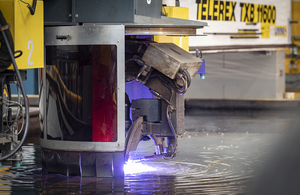There are now three Type 26 frigates under construction after the Duke of Cambridge set the cutters to work on HMS Belfast.
The Queen’s grandson pressed the button on hi-tech machinery at BAE Systems’ Govan yard and lasers began to move across the first steel plate for the £1.2bn warship.And he revealed that his wife will be the official patron of HMS Glasgow – the first ship in the class which is nearing completion in the same shipyard – promising the Duchess of Cambridge would visit for the frigate’s naming ceremony to give her blessings to the ship and all who sail in her.
Led by BAE apprentice Cara Shannon and Type 26 Programme Director David Shepherd, he was also given a tour of HMS Glasgow and chatted with those responsible for her construction in the anti-submarine frigate’s operations room and on the flight deck.
Before setting the cutters to work on steel which will eventually become part of the machinery space which will house HMS Belfast’s gearbox and stabilisers, Prince William told BAE workers and VIPs, including numerous representatives from Northern Ireland and the frigate’s namesake city, how impressed he was by the Type 26 programme.
“The scale of achievement is truly staggering, and all the staff I’ve met here today are rightly proud of what you are doing,” the duke said.
“Proud not just because you are creating these cutting-edge ships, but because you are supporting the Royal Navy and the national security of the United Kingdom.”
And he said his late grandfather, who died in April aged 99, would have been “fascinated and excited to see” the “advances in skills and technology” embodied by Belfast and her sisters.
They are the mid-21st Century successors to ships such as HMS Magpie, the Duke of Edinburgh’s sole command. The 26s – each named after one of the UK’s major cities – will replace the eight ‘souped-up’ Type 23 frigates which are dedicated to submarine hunting, while the five general purpose 23s will be superseded by the Type 31/Inspire class, with work due to begin on the first ship, HMS Active, later this year in Rosyth.
HMS Glasgow is out of the construction sheds at Govan with her fore/aft sections awaiting joining before the ship enters the water to undergo completion, with HMS Cardiff a couple of years behind her and over 40 per cent finished.
“Standing in the shadow of HMS Glasgow which has been brought together on the hard standing, with large parts of HMS Cardiff in construction around us, the steel cut for HMS Belfast is another significant milestone in the delivery of the Type 26 class,” said Vice Admiral Christopher Gardner, Director General Ships at Defence Equipment and Support.
“This is a proud moment for everyone who has worked so hard on this strategic national programme, which sustains thousands of jobs across the United Kingdom and harnesses all of our skills and knowledge to produce the best possible ships/capabilities for the Royal Navy.”
When finished, the 8,000-tonne warships will take their place in the Fleet as the principal line of defence above the waves against hostile submarines, protecting both the UK’s nuclear deterrent and carrier strike/amphibious task groups.
In addition to anti-submarine sensors and weaponry and Merlin helicopter, the octet will also be equipped with Sea Ceptor missiles to fend off air attacks, a 5in main gun, medium range radar and ‘mission bays’ – an adaptable space allowing the ships to load equipment and supplies for a specific mission such as disaster relief, counter-piracy operations or minehunting.
The ships also harness the latest ‘green’ tech and thinking, from the streamlined design of the hull and advanced anti-fouling coating to cut through the waters more efficiently to diesel engines which are kinder to the environment through reduced emissions.
The class will serve as the backbone of the fleet beyond 2060, while their construction is supporting 4,000 jobs across the UK, 1,700 of them in Scotland.
The scale of achievement is truly staggering, and all the staff I’ve met here today are rightly proud of what you are doing







